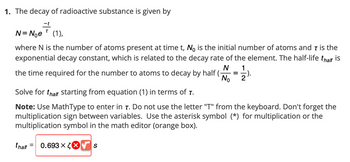1. The decay of radioactive substance is given by 7 N = Noe (1), where N is the number of atoms present at time t, No is the initial number of atoms and T is the exponential decay constant, which is related to the decay rate of the element. The N 1 half-life thalf is the time required for the number to atoms to decay by half ( = No 2 Solve for thalf starting from equation (1) in terms of T. Note: Use MathType to enter in T. Do not use the letter "T" from the keyboard. Don't forget the multiplication sign between variables. Use the asterisk symbol (*) for multiplication or the multiplication symbol in the math editor (orange box). thalf = 0.693 X√ S No, that's not the correct answer.
1. The decay of radioactive substance is given by 7 N = Noe (1), where N is the number of atoms present at time t, No is the initial number of atoms and T is the exponential decay constant, which is related to the decay rate of the element. The N 1 half-life thalf is the time required for the number to atoms to decay by half ( = No 2 Solve for thalf starting from equation (1) in terms of T. Note: Use MathType to enter in T. Do not use the letter "T" from the keyboard. Don't forget the multiplication sign between variables. Use the asterisk symbol (*) for multiplication or the multiplication symbol in the math editor (orange box). thalf = 0.693 X√ S No, that's not the correct answer.
College Physics
11th Edition
ISBN:9781305952300
Author:Raymond A. Serway, Chris Vuille
Publisher:Raymond A. Serway, Chris Vuille
Chapter1: Units, Trigonometry. And Vectors
Section: Chapter Questions
Problem 1CQ: Estimate the order of magnitude of the length, in meters, of each of the following; (a) a mouse, (b)...
Related questions
Question
THE ANSWER IS NOT 0.693

Transcribed Image Text:1. The decay of radioactive substance is given by
7
N = Noe (1),
where N is the number of atoms present at time t, No is the initial number of atoms and T
is the exponential decay constant, which is related to the decay rate of the element. The
N 1
half-life thalf is the time required for the number to atoms to decay by half (
=
No 2
Solve for thalf starting from equation (1) in terms of T.
Note: Use MathType to enter in T. Do not use the letter "T" from the keyboard. Don't
forget the multiplication sign between variables. Use the asterisk symbol (*) for
multiplication or the multiplication symbol in the math editor (orange box).
thalf = 0.693
X√ S
No, that's not the correct answer.
Expert Solution
This question has been solved!
Explore an expertly crafted, step-by-step solution for a thorough understanding of key concepts.
Step by step
Solved in 3 steps with 3 images

Follow-up Questions
Read through expert solutions to related follow-up questions below.
Follow-up Question

Transcribed Image Text:1. The decay of radioactive substance is given by
T
N = Nᵒe (1),
where N is the number of atoms present at time t, No is the initial number of atoms and 7 is the
exponential decay constant, which is related to the decay rate of the element. The half-life thalf is
N
the time required for the number to atoms to decay by half (-
No
=
0.693 x ✔ S
-1/2).
Solve for thalf starting from equation (1) in terms of T.
Note: Use MathType to enter in T. Do not use the letter "T" from the keyboard. Don't forget the
multiplication sign between variables. Use the asterisk symbol (*) for multiplication or the
multiplication symbol in the math editor (orange box).
thalf =
Solution
Knowledge Booster
Learn more about
Need a deep-dive on the concept behind this application? Look no further. Learn more about this topic, physics and related others by exploring similar questions and additional content below.Recommended textbooks for you

College Physics
Physics
ISBN:
9781305952300
Author:
Raymond A. Serway, Chris Vuille
Publisher:
Cengage Learning

University Physics (14th Edition)
Physics
ISBN:
9780133969290
Author:
Hugh D. Young, Roger A. Freedman
Publisher:
PEARSON

Introduction To Quantum Mechanics
Physics
ISBN:
9781107189638
Author:
Griffiths, David J., Schroeter, Darrell F.
Publisher:
Cambridge University Press

College Physics
Physics
ISBN:
9781305952300
Author:
Raymond A. Serway, Chris Vuille
Publisher:
Cengage Learning

University Physics (14th Edition)
Physics
ISBN:
9780133969290
Author:
Hugh D. Young, Roger A. Freedman
Publisher:
PEARSON

Introduction To Quantum Mechanics
Physics
ISBN:
9781107189638
Author:
Griffiths, David J., Schroeter, Darrell F.
Publisher:
Cambridge University Press

Physics for Scientists and Engineers
Physics
ISBN:
9781337553278
Author:
Raymond A. Serway, John W. Jewett
Publisher:
Cengage Learning

Lecture- Tutorials for Introductory Astronomy
Physics
ISBN:
9780321820464
Author:
Edward E. Prather, Tim P. Slater, Jeff P. Adams, Gina Brissenden
Publisher:
Addison-Wesley

College Physics: A Strategic Approach (4th Editio…
Physics
ISBN:
9780134609034
Author:
Randall D. Knight (Professor Emeritus), Brian Jones, Stuart Field
Publisher:
PEARSON